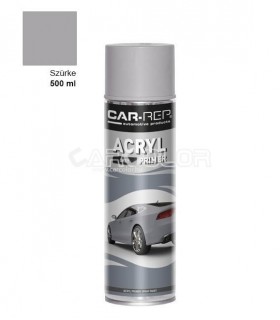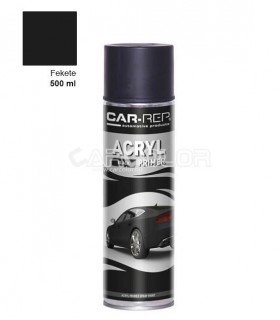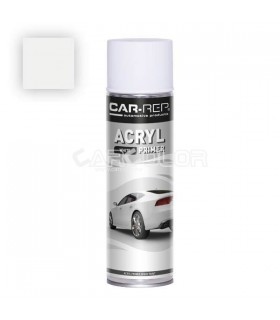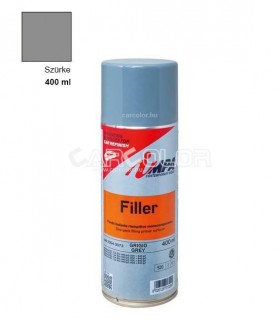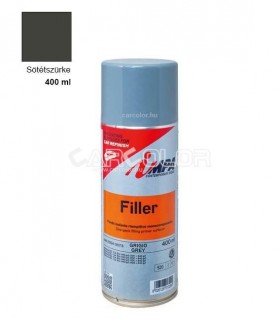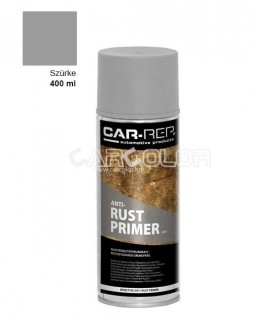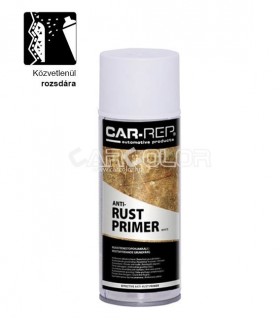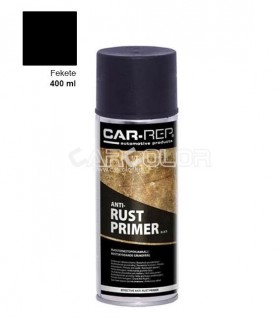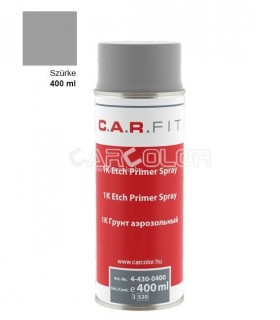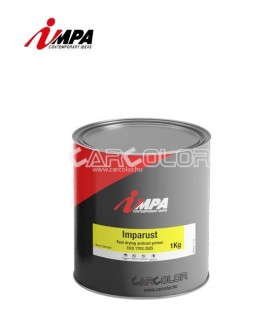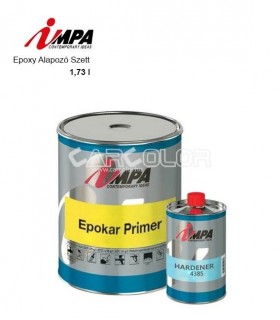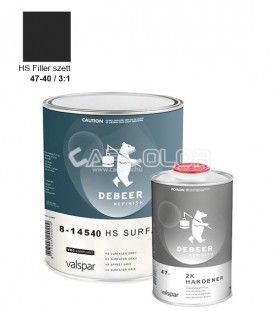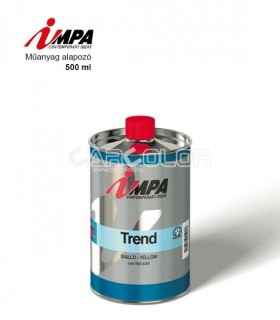Complete Guide to Automotive Primers: Spray (DIY) and Professional (2K) Solutions
In automotive refinishing, primers play a crucial role: they prepare the surface for paint, ensure proper adhesion, level minor imperfections, and protect the surface against corrosion. Whether it’s a full body respray, rust protection for metal surfaces, or repairing plastic parts, choosing the right primer is essential for a durable and aesthetically pleasing result.
Below we review the main types of aerosol (spray) and professional (two-component or specialty) primers, along with tips on when each is the best choice.
Contents...
What does a primer do?
The primer creates an adhesion-promoting layer on the substrate (metal, plastic, old paint), levels surface irregularities, and provides corrosion protection. The goal is a compatible, stable coating stack: primer (adhesion/corrosion protection) → filler primer (surface leveling) → basecoat → clearcoat.
Spray primers (aerosol, DIY)
For small repairs, spot work, and jobs without equipment. Fast, clean, and easy to meter. For large areas and peak durability, 2K spray systems are recommended.
Spray primers are aerosol paints typically used for minor touch-ups, home (DIY) refinishing, or treating hard-to-reach areas. Their advantage is that they require no mixing or spray gun, are simple to use, and deliver an even mist on the surface. They are ready to apply straight from the can, providing a quick solution. Spray primers improve paint adhesion and help ensure a smooth, durable finish.
Limitations: they contain a limited amount of material and are generally less robust, so on large areas or in professional refinishing they often cannot match the durability of two-component (2K) primers. However, for small body repairs and scratch removal they are ideal thanks to their quick drying and easy application.
Acrylic primer spray
The acrylic primer spray is a universal aerosol primer that dries quickly and offers excellent adhesion on a variety of surfaces. It is typically used to prepare metal, plastic, wood, or even concrete before painting. Its fine mist levels nicely, forming a uniform layer. The acrylic primer spray is highly versatile—it works for small automotive touch-ups and household refurbishing—and dries fast so you can proceed sooner. Most acrylic sprays are matte gray (sometimes white, black, or red), which gives good hiding power and easy sanding before paint. As a universal product, it serves as a general-purpose primer that provides an adequate adhesion base for metal, plastics, and even wood. For DIY users it’s often the first choice for smaller jobs because it’s easy to use and yields reliable results.
- Substrate: metal, old paint, wood; small plastics if pre-treated.
- Pros: universal, fast drying, sands well.
- Cons: 1K; less durable than 2K.
- Use: general DIY priming, small body repairs.
- Related category: Acrylic primer spray
Plastic primer spray
The plastic primer spray is an adhesion-promoting primer formulated specifically for plastics. It creates an adhesion-mediating layer so the topcoat bonds more easily and durably. Without it, conventional paints tend to chip off flexible or slick plastics.
Using a plastic primer prevents this: it boosts paint adhesion and ensures the painted plastic remains smooth, durable, and resistant. It’s usually colorless or very light, so it won’t affect topcoat color. Ideal for automotive plastic parts—e.g., bumpers, mirror caps, trim—before painting, and worth using on any plastic item (garden furniture, housings). Benefits include preventing paint chipping from plastic and forming a flexible film that follows plastic deformation. It dries very fast, so the surface becomes paintable shortly. Important: use only on plastic surfaces—it’s not the right primer for metal or wood. For more details, see our previous article on painting plastics.
- Substrate: PP/ABS/PVC plastics (bumper, trim, etc.).
- Pros: adhesion promotion, flexibility, prevents chipping.
- Cons: only for plastics; very thin, “invisible” layer.
- Use: a fine, thin coat before painting.
- Related category: Plastic primer spray
Filler primer spray
The filler primer spray—often called spray putty—is a high-solids aerosol primer that builds a thicker layer. Its purpose is to fill and level small surface defects, scratches, stone chips, or tiny dents before applying the topcoat. It provides a finely sandable, thicker primed layer that smooths uneven surfaces.
With it, the finish after painting becomes much more uniform and mirror-smooth. Application is simple: mist on a few coats to fill scratches and micro-defects, then sand after drying to achieve a perfectly flat surface. Thanks to fast drying, it’s ready to sand quickly, speeding up repairs. Apply several light coats rather than one heavy coat to avoid runs. Spray putties are typically gray and matte. Excellent for small repairs, but for larger areas a 2K filler applied by spray gun is more economical.
- Substrate: leveling repaired, scratched surfaces.
- Pros: high solids, sands well, quick leveling.
- Cons: uneconomical on large areas; 2K filler is more durable.
- Use: several thin coats, then dry sanding.
- Related category: Filler primer spray
Rust-preventive primer spray
The rust-preventive primer spray is an aerosol primer designed specifically to protect metal surfaces against corrosion. These sprays usually contain special anti-corrosion pigments (e.g., zinc phosphate) that form a protective layer on metal, preventing rust formation. They are ideal for treating small rust spots: after removing loose rust and degreasing, apply the rust-preventive spray to halt the process. Advantages include quick drying and easy overcoating with most topcoats. The downside: the protection isn’t as strong as professional 2K primers, so it’s best for small repairs or interim protection. Proper prep is vital: remove rust, dust, and grease thoroughly before priming to ensure good adhesion. Use it for small bodywork rust fixes at home, or to treat drilled edges and cut lines before paint. For serious rust damage, a more thorough process (e.g., rust converter followed by 2K epoxy primer) is recommended for lasting results.
- Substrate: steel/iron; mechanically cleaned rust spots.
- Pros: anti-corrosion pigments, quick to overcoat.
- Cons: 1K; 2K epoxy is more durable on severe rust.
- Use: local rust treatment, cut edges, drill points.
- Related category: Rust-preventive primer spray
More spray products: Spray primer category
Professional automotive primers (2K and specialty)
These require a spray gun and are two-component (base + hardener) or specialty chemistries. In return, they provide outstanding adhesion, chemical and weather resistance, and long service life.
Professional automotive primers are typically two-component (2K) systems or special chemistries that must be applied with a spray gun. They are used mainly in bodyshops and higher-end restorations due to greater coverage, thicker film build, and highly durable, resistant coatings. Before use, the two parts (primer and hardener) are mixed to trigger the chemical cure. 2K primers cure to a harder, more solvent- and chemical-resistant film than 1K products. Specialty primers also include acid etch “washprimers” and adhesion promoters for plastics. The main types:
1K rust-preventive primer
This category includes single-component anti-corrosion primers applied by brush, roller, or spray gun. The 1K rust-preventive primer is ready to use—no hardener or mixing required—so you can apply it immediately. Its goal is to prevent rust and protect metal long-term. Examples include synthetic-resin-based primers that dry quickly and adhere well to iron and steel. Pros: easy handling and generally overcoatable with 1K or 2K topcoats (except certain epoxies). Cons: performance and adhesion may fall short of 2K epoxy, especially under harsh weather or chemical exposure. Commonly used on railings, fences, chassis components, and in cases where quick drying and easy use are key. Also usable in automotive for small repairs when a full 2K system isn’t warranted. As always, thoroughly clean and de-rust before application so the coating can effectively stop corrosion.
- Substrate: steel/iron, industrial and residential uses.
- Pros: ready-mixed, quick work, good adhesion.
- Cons: less protective than 2K epoxy.
- Tip: for light-to-moderate duty; on high-value bodywork prefer 2K epoxy.
- Related category: Rust-preventive primers
2K epoxy primer
The 2K epoxy primer is one of the most important primers in professional refinishing, especially on bare metal or problematic substrates (e.g., aluminum, previously rusted steel). It consists of an epoxy resin base and a hardener; when mixed, they form an extremely strong, hard film. Epoxy offers exceptional adhesion on almost any surface and excellent anti-corrosion properties. After application it hermetically seals the surface, blocking moisture and oxygen, thus protecting metal from corrosion. It also resists fuels, oils, and solvents. Epoxy can serve as an all-purpose foundation: you can apply a filler (Füller) over it or, in some cases, even topcoat. Common use: after a full restoration or panel replacement, epoxy prime the entire shell before color. Because epoxy insulates, it can go over old paint residues, preventing them from re-wetting or bleeding through (see “wet-on-wet” processes). Cons: slower drying and harder to sand than filler, so it’s often applied thinly to metal with a sandable filler on top. Overall, epoxy is ideal when you want the longest-term protection and best adhesion—from classic restorations to industrial parts.
- Substrate: bare metal (steel, aluminum, galvanized), problematic surfaces.
- Pros: top-tier adhesion, sealing layer, high corrosion resistance, chemical resistance.
- Cons: slower to dry, harder to sand, requires mixing.
- Tip: full restorations, classics, heavy duty; can be used wet-on-wet before filler.
- Related category: 2K epoxy primers
2K filler (Füller)
The two-component filler primer—also known as Füller or spray putty—is a staple of body repair and refinish prep. These primers are high-solids with excellent filling properties: they eliminate small dents, scratches, and waviness. The Füller levels the repaired panel, providing a flawless base for color. Typically applied in 2–3 coats by spray gun, then sanded to perfection with fine abrasives (e.g., P400–P800). It dries fast and sands easily, speeding the workflow. It’s indispensable in professional refinishing: after clearcoat there should be no micro-waves or scratches. Available in multiple shades (grays, white, black) to approximate the topcoat color, aiding coverage. Tip: use white/light gray Füller under light colors; dark gray/black under dark colors to improve hiding. In the pro category it’s mixed (2K); as an aerosol it’s only for small repairs. Ensure the surface is rust-free, dust-free, and properly degreased before application or adhesion may suffer.
- Substrate: leveling repaired body panels.
- Pros: high solids, quick drying, excellent sandability.
- Cons: not anti-corrosive by itself (use epoxy/washprimer on bare metal first).
- Tip: 2–3 coats, sand P400–P800; shade to suit the color.
- Related category: 2K fillers – filler primers
Plastic primer (adhesion promoter)
Professional plastic primers serve the same purpose as spray versions—prepping plastics—but come in more concentrated, higher-yield packaging (typically 1 L cans) for spray-gun application. These are usually clear or slightly opalescent liquids applied in a thin film to clean plastic. They form a chemical bond between plastic and subsequent paint layers, preventing cracking or flaking. They are universal adhesion promoters for PP, ABS, PVC, polycarbonate, and many other plastics. In automotive use they’re typical on bumpers, mirror housings, and trims. They dry in minutes and can then be topcoated with acrylic/urethane, or first filled, per the TDS. A major advantage is that they preserve plastic flexibility—the film won’t crack as the plastic flexes. Always apply only a thin “dust” coat: heavier coats won’t improve adhesion and may run or diminish bond strength. On very smooth, glassy plastics, light sanding and thorough degreasing improves adhesion. Overall, plastic primer is essential for durable, attractive finishes on plastics, as it prevents future delamination from flexible surfaces.
- Substrate: PP/ABS/PVC, PC, etc. automotive plastics.
- Pros: chemical adhesion, flexibility, fast overcoat.
- Cons: only effective as a very thin “mist” coat.
- Tip: thorough degreasing, fine matting, very light application.
- Related category: Plastic primers
Washprimer (acid etch)
Washprimer, or acid etch primer, is a special two-component primer used specifically on bare metals (steel, galvanized sheet, aluminum, etc.) before painting. Its strongly acidic components react with the metal: their etching action removes oxides while depositing a thin phosphate layer to improve adhesion. Washprimer should be applied very thinly (just “etch” the surface)—the goal is chemical pretreatment, not film build.
Its anti-corrosion effect is significant: it prevents rust, so it’s often used when large areas of a repaired panel are bare metal. It’s also useful on aluminum or stainless steel, where conventional primers struggle—acid components help bond to these “hard-to-paint” substrates.
Note that most washprimers must not be left uncoated: they’re relatively porous and can allow moisture over time. Therefore, apply a secondary layer—typically a 2K filler—within a few hours before the topcoat.
Pros: outstanding adhesion promotion on difficult substrates, excellent corrosion protection even in thin films, and quick recoat (paintable within 10–15 minutes).
Cons: only for metals—cannot be used on plastics or wood—and requires mixing with a relatively short pot life. Bodyshops often use it on new bare metal panels: first washprimer for adhesion and protection, then the remaining primer/paint layers.
- Substrate: bare steel, aluminum, galvanized.
- Pros: etches, phosphates, provides adhesion and corrosion protection in a thin coat.
- Cons: porous—must be covered with filler soon; metals only.
- Tip: ideal on new panels; follow the manufacturer’s specified stack.
- Related category: 2K washprimers
Selection guide (DIY vs. Pro)
Each primer type has different properties and use cases—always match the product to the substrate and objective. For hobby-level, small repairs, spray primers are practical (especially acrylic, or filler spray for scratch leveling). They require no compressor or expertise and yield quick results. For plastic parts, never skip a plastic primer—spray or gun-applied—otherwise the paint may soon delaminate. On rusting metal, first remove or convert the rust, then use a rust-preventive primer—spray for small spots, but for larger projects choose 2K epoxy or a 1K rust-preventive paint primer. For professional refinishing or high-value vehicles, use the full 2K system: start with an epoxy primer (maximum adhesion and corrosion protection), then 2K filler for surface perfection, followed by color and clear. In special cases—e.g., aluminum bodies or new galvanized parts—include washprimer before or instead of epoxy per the TDS to ensure adhesion. Always follow mixing ratios, flash/off times, and compatibility guidance. The right primer, properly applied, ensures the finish stays beautiful for years and the body remains protected from weather and rust.
- Small, local repair: acrylic spray, filler spray → fine sanding → color/clear.
- Plastic parts: plastic primer (spray or gun) → acrylic/urethane topcoat.
- Fresh, bare metal: 2K epoxy (or washprimer) → 2K filler → color/clear.
- Rust treatment: mechanical/chemical prep → rust-preventive (small: spray; large: 2K epoxy) → filler → color/clear.
- Longevity priority: 2K systems (epoxy + filler) are the most stable solution.
Comparison table
| Type | Substrate | Main advantage | Main drawback | DIY / Pro | Quick tip |
|---|---|---|---|---|---|
| Acrylic spray | Metal, old paint | Universal, fast | 1K, moderate durability | DIY | Multiple thin coats |
| Plastic spray | PP/ABS/PVC | Adhesion promotion | Plastics only | DIY/Pro | Very light “dust” coat |
| Filler spray | Repaired area | Fast leveling | Costly on large areas | DIY | Thin coats + sanding |
| Rust-preventive spray | Steel/iron (local) | Quick corrosion barrier | 1K; weak on severe rust | DIY | Thorough prep first |
| 1K rust-preventive | Steel/iron | Easy to use | Weaker than epoxy | Pro/DIY | Check topcoat compatibility |
| 2K epoxy | Bare metal, Al, Zn | Top adhesion & protection | Slower, mixing required | Pro | Follow with 2K filler |
| 2K filler | Repaired panel | Excellent sandability | Not anti-corrosive | Pro | Shade to suit color |
| Washprimer | Bare metal/Al/Zn | Phosphating, adhesion | Not directly coatable with polyester materials | Pro | Very thin etch coat |
Common mistakes
- Painting plastics without a plastic primer: chipping—always use a plastic primer.
- Using only filler on bare metal: not anti-corrosive—apply epoxy or washprimer first.
- Too heavy spray coats: runs, slow drying—aim for multiple thin coats.
- Contaminated/greasy surface: adhesion failure—professional degreasing is essential.
- Ignoring compatibility: always follow the manufacturer’s guidance for 1K/2K system compatibility.
Step-by-step decision tree
- Identify the substrate: plastic → plastic primer; bare metal → epoxy/washprimer; old paint → acrylic or direct Füller (depending on condition).
- Define the task: adhesion/corrosion only → acrylic/epoxy/rust-preventive; surface leveling → Füller.
- Set durability expectations: quick fix → spray; long-term/pro → 2K system.
- Optimize hiding: light colors → light Füller; dark colors → dark Füller.
Summary
For DIY repairs, spray primers offer a quick, clean solution; for durability and larger areas, the 2K epoxy + 2K filler stack is the safest bet. Never skip adhesion promoter on plastics, and on bare metal think epoxy or washprimer first. Following the TDS and thorough surface prep ultimately determine finish quality.









